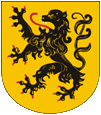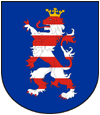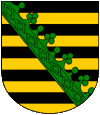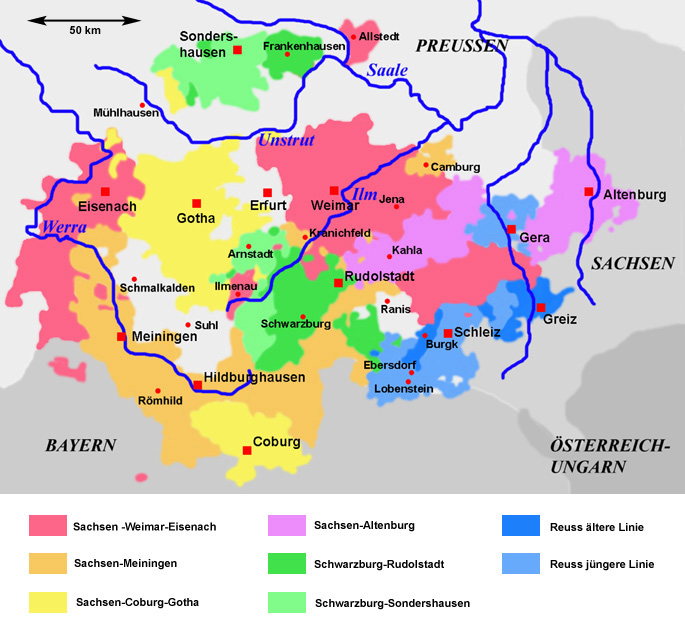mobile View, to the German Version tap the flag


- House of Wettin, also: Wettins
- Margraves of Meissen
- Dukes, Electors and Kings of Saxony
• History of the House of Wettin
• clickable map of the Thuringian States
The House of Wettin is an old German dynasty from the Nordschwabengau (region between Saale River, Bode River and Harz Mountains). The Margraviate of Landsberg, located approximately between Torgau, Landsberg, Sangerhausen and Merseburg, is considered to be the homeland of the House of Wettin. The coat of arms of the county became the coat of arms of the dynasty. It shows two blue posts on gold (Landsberg Posts).

Coat of arms of the Margraviate Landsberg
The first in documents mentioned Wettin was Burkhard (born 908), the Margrave of the Sorbian Mark. His descendant Thimo (born 1091) earned castle and County of Wettin. Conrad I. (born 1157, son of Thimo) acquired the Mark Meissen, the heartland of modern Saxony. Henry the Illustrious acquired in 1263, the County of Thuringia.

Coat of arms of the Margraviate of Meissen

Coat of arms of the Landgraviate of Thuringia
In 1423, Margrave Friedrich IV. earned the Duchy of Saxony-Wittenberg and the electoral dignity (the right to elect the emperor) and the function of the Arch Marshal. The Wettin became in this way Margraves of Meissen and Electors of Saxony-Wittenberg. The Electorate of Saxony-Wittenberg consisted of two territories, Saxony (north of the Elbe River, east of Hamburg near Lauenburg) and Wittenberg (north of the Elbe River, east of Magdeburg). The name of Saxony was thus linked with Wittenberg, and the Wettin became electors, they transferred the with the electors dignity bond name of Saxony to all their possessions, so the Mark Meissen. In this way the Mark Meissen became to the today known Saxony.

Coat of arms of the Duchy of Saxony
In 1485 was the division of the Wettin possessions (Leipzig division) under the two brothers Elector Ernst and Duke Albrecht III. Since this moment in time existed two lines, the Albertines (Duchy of Saxony [former Mark Meissen and areas around the Palatinate County of Saxony in Northern Thuringia], capital of Meissen) and the Ernestines (Electorate of Saxony [Southern Thuringia and Wittenberg area], capital Wittenberg). The Ernestine Saxon Elector Friedrich the Wise, John the Steadfast and Johann Friedrich I (the Magnanimous) supported the Lutheran Reformation. In the War of Schmalkalden (1546/1547) the covenant of the Lutherans subjected to the Imperial Catholics. In the capitulation of Wittenberg (1547) the Ernestines had to cede all areas outside of Thuringia (e.g. Wittenberg) and the electoral dignity to the Albertines. That means that the Duchy of Saxony was now (much reduced) placed in Thuringia and the Electorate of Saxony in the Mark of Meissen, Wittenberg and Northern Thuringia.
After the death of the Ernestine Johann Friedrich I. in 1554 the Duchy of Saxony was divided among his heirs, and there arised the Duchies of Saxony-Weimar, Saxony-Coburg and Saxony-Eisenach. In 1603, splited by inheritance from of Saxony-Weimar the Duchy of Saxony-Altenburg. Around 1633 Saxony-Coburg came to Saxony-Eisenach, and Saxony-Coburg-Eisenach in 1638 was inherited by Sachsen-Altenburg and Saxony-Weimar, so that left only these two Ernestine duchies. Already in 1640, splited by inheritance the Duchies of Saxony-Eisenach and Saxony-Gotha from Saxony-Weimar. In 1644 Saxony-Eisenach was inherited by Saxony-Gotha and Saxony-Weimar and in 1672 Sachsen-Altenburg was inherited by Saxony-Gotha and Saxony-Weimar, and Saxony-Weimar splited into three lines: the Duchy of Saxony-Weimar, the Duchy of Saxony-Jena and the Principality of Saxony-Eisenach. Saxony-Jena ended in 1690 and was inherited by Saxony-Eisenach and Saxony-Weimar. Saxony-Eisenach was inherited by Saxony-Weimar and in this way was created the Duchy of Saxony-Weimar-Eisenach in 1741, it became in 1815 a Grand Duchy as a result of the Congress of Vienna and persisted until 1918. The in 1640 arised Duchy of Saxony-Gotha was divided among seven(!) brothers in 1680/1681. There arised as countries, the Duchies of Saxony-Gotha-Altenburg, Saxony-Meiningen and Saxony-Coburg, and as well as nominally (without its own national sovereignty) the Duchies of Saxony-Eisenberg and Saxony-Hildburghausen, and further nominally (without its own national sovereignty), the Principalities of Saxony-Römhild and Saxony-Saalfeld. Saxony-Coburg ended in 1735 ended and was inherited in 1735 by Saxony-Meiningen and Saxony-Saalfeld. The resulting Duchy of Saxony-Coburg-Saalfeld joined the Rhine Confederation in 1805, and became fully sovereign. Saxony-Eisenberg ended 1701 and was inherited by Saxony-Gotha-Altenburg. Saxony-Römhild ceded territories in 1702 to Saxony-Meiningen and Saxony-Hildburghausen, which was superior in consequence, and got its own sovereignty. Saxony-Römhild ended in 1710 finally and was inherited by Saxony-Gotha-Altenburg and Saxony-Coburg-Saalfeld. Thus existed from 1741 only five Ernestine duchies. These were: Saxony-Weimar-Eisenach (to 1918), Saxony-Gotha-Altenburg, Saxony-Hildburghausen, Saxony-Meiningen (to 1918) and Saxony-Coburg-Saalfeld.
The Albertine line was not so affected by heritage-divisions, so only between 1657 and 1746 existed some more Albertine territories in addition to the Electorate of Saxony: the Duchy of Saxony-Weissenfels, the Principality of Querfurt, the County of Barby, the Duchy of Saxony-Merseburg and the Duchy of Saxony-Zeitz. In 1746 all heritage-divisions were extinguished and the only Albertine territorry was the Electorate of Saxony. This joined in 1805 to the Rhine Confederation and in 1806 it was levied by the Emperor Napoleon to a Kingdom (King Frederick Augustus I.), which persisted until 1918.
In 1825 ended the Ernestine line of Saxony-Gotha-Altenburg and emerging inheritance disputes led on 12th of November in 1826 an award of the family head of Wettin, Frederick Augustus I. of Saxony, who regulated a new division of the duchies: Saxony-Coburg-Saalfeld cedes Saalfeld to Saxony-Meiningen and receives for this Saxony-Gotha. The result is the Duchy of Saxony-Coburg-Gotha, which persisted until 1918. The Duke of Saxony-Hildburghausen takes over Saxony-Altenburg (to 1918), and the lands of Hildburghausen became connected for the most parts to Saxony-Meiningen . Some territories came to the Duchy of Saxony-Coburg-Gotha.
The revolution of 1918 deprived the Wettin their possessions, but the two lines, the Albertines and Ernestines continued until the present days.
Source:
Volker Preuß

• Grand Duchy of Saxony–Weimar–Eisenach
• Duchy of Saxony–Meiningen
• Duchy of Saxony–Altenburg
• Duchy of Saxony–Coburg–Gotha
• Principality of Schwarzburg–Rudolstadt
• Principality of Schwarzburg–Sondershausen
• Principality Reuss Senior Line (Reuss-Greiz)
• Principality Reuss-Schleiz (to 1848)
• Principality Reuss-Lobenstein-Ebersdorf (to 1848)
• Principality Reuss Junior Line (Reuss-Gera), from 1848


Source:
Atlas zur Geschichte,
Landkarte: Volker Preuß


![]()





